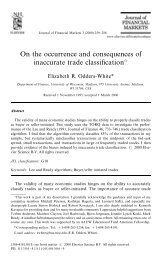A generic framework for Arabic to English machine ... - Acsu Buffalo
A generic framework for Arabic to English machine ... - Acsu Buffalo
A generic framework for Arabic to English machine ... - Acsu Buffalo
You also want an ePaper? Increase the reach of your titles
YUMPU automatically turns print PDFs into web optimized ePapers that Google loves.
sentence and its linking algorithm can work in both directions from syntactic representa-<br />
tion <strong>to</strong> semantic representation, or vice versa. In RRG, semantic decomposition of pred-<br />
icates and their semantic argument structures are represented as logical structures. The<br />
lexicon in RRG takes the position that lexical entries <strong>for</strong> verbs should contain unique in-<br />
<strong>for</strong>mation only, with as much in<strong>for</strong>mation as possible derived from general lexical rules.<br />
For this reason and due <strong>to</strong> the functional nature of our linguistic model, we will create<br />
our own lexicon.<br />
We use the RRG theory <strong>to</strong> motivate the architecture of the lexicon and the RRG bidirec-<br />
tional linking system <strong>to</strong> design and implement the parse and generate functions between<br />
the syntax-semantic interfaces. Through an input process with seven phases, including<br />
morphological and syntactic unpacking, UniArab extracts the universal logical structure<br />
of an <strong>Arabic</strong> sentence. Using the XML based metadata representing the RRG logical<br />
structure (XRRG), UniArab accurately generates an equivalent grammatical sentence in<br />
the target language through four output phases. We outline the conceptual structure of<br />
the UniArab System which utilizes the <strong>framework</strong> and translates the <strong>Arabic</strong> language<br />
in<strong>to</strong> another natural language. We follow the Interlingua design approach <strong>for</strong> <strong>machine</strong><br />
translation. We analyse the <strong>Arabic</strong> sentences <strong>to</strong> create a universal, abstract logical repre-<br />
sentation, and from this representation we generate <strong>English</strong> translations.<br />
We also explore how the characteristics of the <strong>Arabic</strong> language will affect the develop-<br />
ment of a Machine Translation (MT) <strong>to</strong>ol. Several characteristics of <strong>Arabic</strong> pertinent<br />
<strong>to</strong> MT will be explored in detail with reference <strong>to</strong> some potential difficulties that they<br />
present. We will conclude with a proposed model incorporating the Role and Reference<br />
Grammar techniques <strong>to</strong> achieve this end. The UniArab system has been tested by gener-<br />
ating equivalent grammatical sentences, in <strong>English</strong>, via the universal logical structure of<br />
<strong>Arabic</strong> sentences, based on MSA <strong>Arabic</strong> input with very significant and accurate results.<br />
ii
















